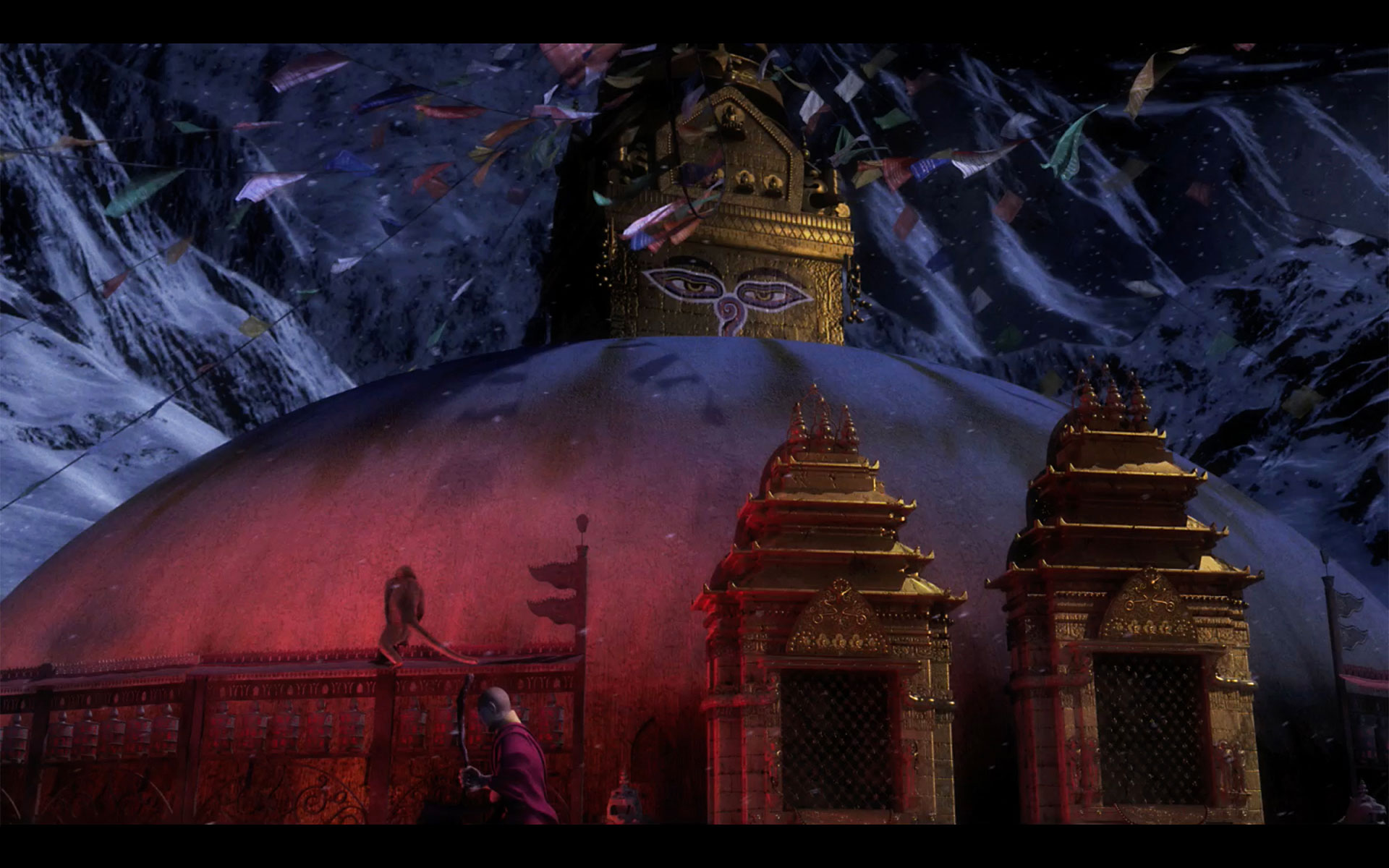
SHAMBHALA (2002)
This establishing shot set the stage for an ambitious animated feature film set high up in the Himalayas on the Tibetan plateau. Our hero’s adventure is a magical mystery tour in search of the hidden realm of Shambhala, and what awaits within.
SWAYAMBUNATH
They named this place Swayambunath, or “The Self Created”. Swayambunath is sacred to both the Hindus as well as the Buddhists. For Buddhists, the stupa shrine is the most ancient symbol of man’s profound quest for higher consciousness, the search for Dharmadatu Jnan, or “the being as one with the universal spirit.” It is inspired by the shape of Mount Meru – the mythological center of the universe.
On the stupa are painted the omnipresent eyes of Buddha that sweep over all beings as if to “warn the earthly creatures” to do only the right things. The brightly painted eyes and nose that look like a question mark survey the Kathmandu valley with a piercing stare. The round dome which stands elevated is the representation of all four elements; the fire, the earth, the wind, and the water. The steps leading to it are the symbolic steps to Nirvana. On any given day numerous multi-colored flags inscribed with prayers and tied to strings dance gently to the tune of the wind. These prayers are said to be carried to the gods by the wind.
Stupa architecture developed from an early belief that certain naturally occurring geometric shapes stored, generated, and amplified energy. Through the act of ritual circumambulation – circling the stupa in a clockwise direction while repeating sacred mantra syllables – energy is created. The stupa is a guide to the evolution of the psyche and the five levels correspond to the ascending psychic energy centers, or chakras, of the human body.
Large stupas are entered through four directional portals, each of which depicts an important passage in the life of the Buddha: the eastern entrance celebrates his birth; the southern marks his enlightenment; the western highlights his proclamation of the Dharma; and the northern represents his attainment of Nirvana, or liberation. The largest stupas in the world – Shwedagon, Borobudur, Nakhorn Pathom, and Baudha – are psychocosmograms, physical “maps” to enlightenment. When viewed from above, they appear as mandalas.
The Swayambunath stupa is maintained by the monks of the Tibetan Kagyupa Order and is believed to enclose the actual Jyotirupa, or “self existent” light of Swayambhu. Used to protect against evil spirits, confer blessings, and purify all who circle it, the stupa is an architectural representation of the ultimate nature of reality; a key unlocking the door to the cosmological paradise of the gods, and ultimately, to nirvana.


SHAMBHALA (2002)
This establishing shot set the stage for an ambitious animated feature film set high up in the Himalayas on the Tibetan plateau. Our hero’s adventure is a magical mystery tour in search of the hidden realm of Shambhala, and what awaits within.
SWAYAMBUNATH
They named this place Swayambunath, or “The Self Created”. Swayambunath is sacred to both the Hindus as well as the Buddhists. For Buddhists, the stupa shrine is the most ancient symbol of man’s profound quest for higher consciousness, the search for Dharmadatu Jnan, or “the being as one with the universal spirit.” It is inspired by the shape of Mount Meru – the mythological center of the universe.
On the stupa are painted the omnipresent eyes of Buddha that sweep over all beings as if to “warn the earthly creatures” to do only the right things. The brightly painted eyes and nose that look like a question mark survey the Kathmandu valley with a piercing stare. The round dome which stands elevated is the representation of all four elements; the fire, the earth, the wind, and the water. The steps leading to it are the symbolic steps to Nirvana. On any given day numerous multi-colored flags inscribed with prayers and tied to strings dance gently to the tune of the wind. These prayers are said to be carried to the gods by the wind.
Stupa architecture developed from an early belief that certain naturally occurring geometric shapes stored, generated, and amplified energy. Through the act of ritual circumambulation – circling the stupa in a clockwise direction while repeating sacred mantra syllables – energy is created. The stupa is a guide to the evolution of the psyche and the five levels correspond to the ascending psychic energy centers, or chakras, of the human body.
Large stupas are entered through four directional portals, each of which depicts an important passage in the life of the Buddha: the eastern entrance celebrates his birth; the southern marks his enlightenment; the western highlights his proclamation of the Dharma; and the northern represents his attainment of Nirvana, or liberation. The largest stupas in the world – Shwedagon, Borobudur, Nakhorn Pathom, and Baudha – are psychocosmograms, physical “maps” to enlightenment. When viewed from above, they appear as mandalas.
The Swayambunath stupa is maintained by the monks of the Tibetan Kagyupa Order and is believed to enclose the actual Jyotirupa, or “self existent” light of Swayambhu. Used to protect against evil spirits, confer blessings, and purify all who circle it, the stupa is an architectural representation of the ultimate nature of reality; a key unlocking the door to the cosmological paradise of the gods, and ultimately, to nirvana.
